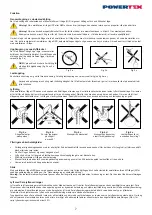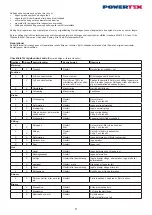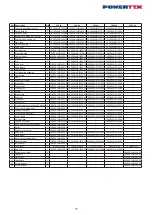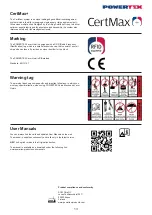
4
E
K
Daily checks
After every working day on which the lever hoist has been used, the following should be checked:
•
Is the lever hoist deformed or otherwise damaged? Are any parts missing?
•
Is any deformation or other damage visible on the suspension device (eye, shackle, bolt or similar)?
•
Are the hooks intact or have any hooks opened? Are the hook latches correct and functional?
•
The selector must work without problems.
•
Wipe down the lever hoist and oil the chain as required.
•
The chain must be undamaged, i.e. no signs of wear and no deformed or otherwise damaged links.
•
The chain must not be kinked or twisted.
•
The chain stop must free of deformation or other damage.
•
The brake function must be intact.
In the event of faults or failures, the hoist must be repaired and carefully checked by a specialist before reuse.
Continuous maintenance - lubrication
Oil the hook latches and bearings. Grease the pawl and ratchet and also the gear. Lubrication must be sparingly and carefully applied so no
grease gets on the brake disk. Oil the chain for longer life.
Periodic checks
Periodic checks are normally carried out yearly to detect and remedy any faults. If required (e.g. high frequency of use), more frequent checks
may be carried out. See “Checklist for periodic checks”. Measure hooks and chain to detect any changes in shape.
Hook checks
(see fig 6 and Table 2)
Opening dimension E on the hooks is important. A hook with too large a maximum dimension has been
exposed to overloading or overheating. It therefore does not have the necessary load capacity. The
hooks may also have been exposed to long-term wear (dimension K).
Hooks must be discarded and replaced if:
•
the maximum E value is exceeded (according to Table 2)
•
the minimum K value falls short (according to Table 2)
•
the hook is cracked, deformed or otherwise damaged.
Defective hooks must be replaced before using the lever hoist again!
Table 2
Hook dimensions
Check measurement of chain
(See Fig. 7 and table 3)
Inspect the chain over its whole length to detect any deformed
or otherwise damaged links. Make a check measurement of
suspect links. Measure the worn areas Also, every 300 mm
(normally), take check measurements of the internal length of 5
links (pitch dimension 5xP according to Table 3).
Table 3
Chain dimensions Fig 7 Checking chain dimensions
Fig. 6 Load hook
Max. load tonnes
0,25
0,5
0,75
1,5
3,0
Model
PALH-S1
PALH-S1
PALH-S1
PALH-S1
PALH-S1
Link diameter nominal mm
3,0
4,0
5,0
7,1
7,1
Link diameter min. mm
2,7
3,6
4,5
6,4
6,4
Pitch dimension (5xP) nominal mm
45,0
60,0
85,0
100,5
100,5
Pitch dimension (5xP) max. mm
46,3
61,8
87,5
103,5
103,5
Max. load tonnes
0,25
0,5
0,75
1,5
3,0
Model
PALH-S1
PALH-S1
PALH-S1
PALH-S1
PALH-S1
Dimension E nominal mm
35,47
41,70
41,56
52,08
62,0
Dimension E max. mm
38,29
44,84
44,69
55,73
66,5
Dimension K nominal mm
12,9
15,6
20,0
26,5
31,2
Dimension K min mm
11,6
14,0
18,0
23,8
28,0
Summary of Contents for 16.20PALHS10025030
Page 12: ...12 ...





















